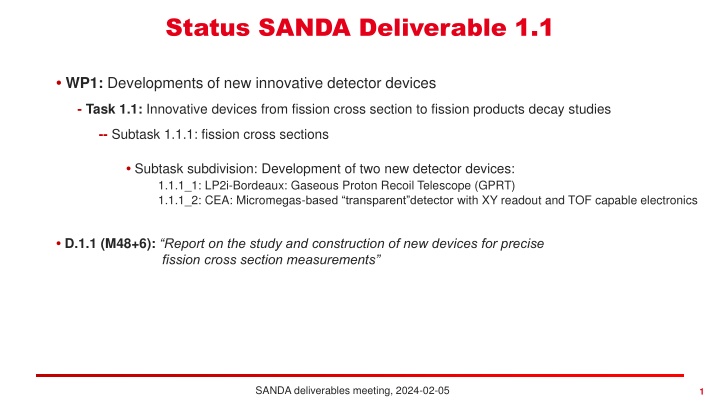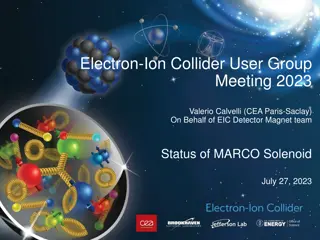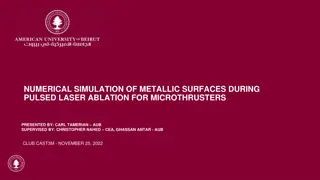
Innovative Detector Devices for Fission Studies: GPRT and XyMegas
Explore the development of innovative detector devices, including the Gas Proton Recoil Telescope (GPRT) and Micromegas-based transparent detector XyMegas, for precise fission cross-section measurements and neutron flux measurements in nuclear research.
Download Presentation

Please find below an Image/Link to download the presentation.
The content on the website is provided AS IS for your information and personal use only. It may not be sold, licensed, or shared on other websites without obtaining consent from the author. If you encounter any issues during the download, it is possible that the publisher has removed the file from their server.
You are allowed to download the files provided on this website for personal or commercial use, subject to the condition that they are used lawfully. All files are the property of their respective owners.
The content on the website is provided AS IS for your information and personal use only. It may not be sold, licensed, or shared on other websites without obtaining consent from the author.
E N D
Presentation Transcript
Status SANDA Deliverable 1.1 WP1: Developments of new innovative detector devices - Task 1.1: Innovative devices from fission cross section to fission products decay studies -- Subtask 1.1.1: fission cross sections Subtask subdivision: Development of two new detector devices: 1.1.1_1: LP2i-Bordeaux: Gaseous Proton Recoil Telescope (GPRT) 1.1.1_2: CEA: Micromegas-based transparent detector with XY readout and TOF capable electronics D.1.1 (M48+6): Report on the study and construction of new devices for precise fission cross section measurements SANDA deliverables meeting, 2024-02-05 1
GPRT detector ? e- Goal: accurate neutron flux measurement, relative to H(n,n) p ? Detector characteristics: Gas detector: to reduce /e sensitivity Two chambers with collimator: . to select only forward protons and define precisely the detection efficiency collimators Micromegas detector: . combination of ionization chamber (low electric field) and proportional chamber (high electric field) . high range in gain, good radiation hardness, good timing . for signal amplification E region H-rich foil E region Segmented: . crude segmentation in 64 pads . enables to reconstruct proton track and help background discrimination E-E chambres TPC: . drift time measurement . enables to reconstruct 3D proton track and infer initial neutron energy Segmented Micromegas detector H-rich foil SANDA deliverables meeting, 2024-02-05 2 Ludovic MATHIEU, LP2i Bordeaux CNRS
GPRT detector: status Detector performances: - very low sensitivity to /e- - 3D track reconstruction - good electric behaviour - suitable N2-CO2mixture (good gain, good timing) DAQ performances: - an efficiency issue which lasted a very long time - problem now identified, due to incorrect signal transmission - in low performance mode , = 100% and dead time manageable minimal performance requirements met ! attenuated noise corrected baseline signal correction Analysis tools: - goal: automatic data sorting, background correction, parasite correction... - implemented features: . navigation through data . data plotting (spectra and 2D) . parasitic correction Contribution to the D1.1 report: still planed by end of February 2D view of proton track, with timing info SANDA deliverables meeting, 2024-02-05 3 Ludovic MATHIEU, LP2i Bordeaux CNRS
XyMegas detector Goal: develop a Micromegas microbulk neutron detector which combines: - neutron beam imaging and neutron flux measurements - neutron-induced (n,f) and (n,lcp) reaction cross sections - angular distributions of neutron-induced reactions Micromegas detectors: - Gaseous parallel plate detectors for charged particles and X-ray and UV photons, - Neutron detection possible via neutron to charged-particle conversion. - type bulk (PCB integrated) - type microbulk (double sided copper-coated Kapton foil) incoming neutron beam, typical diameter between 1 and 10 cm cathode HV3 (n,lcp) reaction drift cathode with deposit 6Li(n,a)3H, 10B(n,a)7Li, 235U(n,f) variable drift gap, typically 1-100 mm ionization track gas in drift and amplification volume 1 kV/cm Technical implementation: Micromegas low-mass microbulk detector (transparency) with X- and Y-strips produced with Laser Direct Imaging (LDI) New data acquisition system based on dedicated VMM3 chip for neutron time-of-flight environment e mesh HV2 amplification gap, 50 m 100 kV/cm HV1 anode 1 2 3 4 SANDA funding completed with French ANR project XyMegas, in partnership with JRC-Geel SANDA deliverables meeting, 2024-02-05 4 Frank Gunsing, CEA Irfu, University Paris-Saclay
XyMegas detector: status Prototype (manufactured at CERN): - 50 m thick detector transparent microbulk detector - 128x128 strips - geometrical quantification done - mounted in detector chamber DAQ: - VMM3 development board received. - PCB boards designed and produced to interface VMM3 electronics and HV distribution Tests: in lab environment using a 55Fe X-ray source Postdoc recruitment: - a first postdoc could be recruited only early 2022 and has left by the end of 2022 because of family reasons - a second postdoc was recruited early 2023 and has advanced on the simulations part using FLUKA, Garfield++, and GEANT4. Contribution to the D1.1 report: - with a focus on the simulations - is still expected by end of February. Example of a 6Li(n,a) particle range inside the detector The full D.1.1 report still needs merging and final review SANDA deliverables meeting, 2024-02-05 5 Frank Gunsing, CEA Irfu, University Paris-Saclay




















